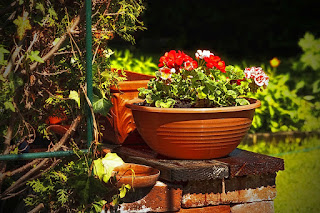Keep your garden fortified
Garden
like a lonely child needs care. Moreover, it needs plenty of nutrition or
fertilizer. For those novice gardeners, here is some speedy lowdown on
gardening basics.
 |
| jill111 Pixabay |
Gardeners
sometimes tend to forget that garden plants have life. Like all living
organisms, plants need these basic elements for growth.
Ø Soil
Ø Air
Ø Water
Ø Nutrition
Dimensions of your garden bed
This is your starting point in gardening basics. If you
want to grow small plants, you have to use nursery beds and compost pits help you use organic fertilizing method. Novice gardeners should mark the outer lines
and passage in between various sections of this garden bed. Then choose your
bed area according to your crop size.
Prepare your soil: Gardening
basics
It does not matter if your soil has too much of clods or has no
nutritive value. You can prepare your garden soil so that it is just right for
your plants. To do this, follow gardening basics and remove that hard top layer
of earth using a pickax to dig about 3 – 5 inches deep and a shovel to remove
the soil. Now, in another part of the garden prepare a mix of red soil, sand
and compost or you can add fertilizers if your garden does not have a compost
pit. Turn this prepared soil over many times and let it air and dry completely.
Once you are reasonably certain that your soil is dry and usable, spread it
around all over the marked bed area. Novice gardeners should note that nutrients will be lost easily to
atmosphere and water. So, you must make haste and plant your crops immediately.
It is a good idea to spread some dried leaves over your prepared soil in this
respect.
Make room for air
One of kitchen garden basics deals with air required by roots for
proper growth. You have to make sure that the soil is loose and has plenty of
air pockets. If you add sand, this will ensure good drainage and passage of air
as well. However, excess sand will lead to water seeping off into the ground.
Go easy on water
Over watering will cause roots to rot away. So, avoid
stagnation of water in your garden. Keep water flowing in a gentle slope so
that stagnation does not occur.
Do not spare the nutrition
Nutrition is very essential aspect of gardening basics. Kitchen garden soils that have enough nutritive value will help you raise crops that are
appreciably bigger and tastier. The basic components will be the following.
a)
Nitrogen
b)
Phosphorus
c)
Potassium
d)
Calcium
e)
Magnesium
All fertilizer bags will mention these basic components.
It will be depicted as 40 – 12 – 20 meaning that each bag contains 40 parts of
nitrogen, 12 parts of phosphorus and 20 parts of potassium. If your bag is 40
kg in weight, then you have 22.222 kg of nitrogen, 6.666 kg of phosphorus and 11.111
kg of potassium.
Choosing your kitchen garden crop
Usual kitchen garden vegetables are cucumber, greens,
cabbage, onion, carrots, beans, peas, radish, pumpkin, drumstick and beets.
Fruits like papaya, banana, mango, jackfruit and grapes are also favorites with
home garden enthusiasts. They also grow various spices and herbs like
coriander, basil, dill, parsley, sage, thyme, pepper, mint and curry leaves. These
are best choices for novice gardeners who are still struggling with their
gardening basics.
Check on nutrient requirements
Now each of these has a specific nutrient requirement. In
general, nitrogen is required more since this is lost more rapidly to
environment. Most fertilizer mixes would have more nitrogen content though some
would have excess of potassium. In gardening basics for novice gardeners, one of the first things is that one should readily recognize marks on labels of fertilizer mixes that would read something like 50 –12 – 20
or 15 – 8 – 20. The first figure represents the nitrogen content while the last
one represents the potassium content. The one in the middle would be your
phosphorus.
 |
| PeterDargatz Pixabay |
Plan your fertilizer
application procedure
Fertilizing your garden could include random acts of
kindness like throwing ash or fish meal in your vegetable bed or lawn or it
could be a calculated act of strategy like using fertilizer rich in nitrogen
(three to four times that of phosphorus and about twice that of potassium) for
your lawn and fertilizer rich in potassium about twice the nitrogen content.
Phosphorus requirement is less since they deplete slower. If there were one
sixth to one tenth of phosphorus content, it would suffice for most kitchen
gardens. Vegetables would require more potassium while leafy vegetables like
spinach or greens would require more nitrogen. If you are a novice gardener, once you are thorough with
gardening basics, you will find this art more enjoyable.











